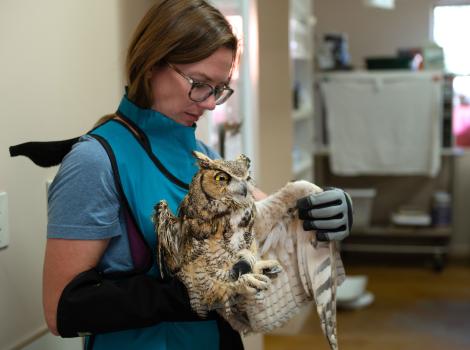Heron gets emergency surgery and second chance at life

Clouds scuttled across the sky, casting shadows over the calm waters of Jackson Flat Reservoir just a few miles from Best Friends Animal Sanctuary. This is where a concerned person found a young night heron in distress — a long, shimmering fishing line hanging from the bird’s beak likely from swallowing a hook. They knew the heron needed help and contacted Wild Friends, Best Friends’ state- and federally licensed wildlife rehab center. Time was ticking to locate and remove the hook that was likely inside the bird.

A delicate procedure
The Wild Friends team determined the heron needed an endoscopy — a procedure that uses a small camera to see inside the body — to look for a hook. Fortunately, the bird was in experienced hands.
Dr. Nicole Smee, a veterinary specialist consulting with Best Friends, was at the Sanctuary for a meeting when the call came in about the heron. “I have experience using endoscopy equipment to remove fishhooks from animals, so I stayed to help,” says Dr. Nicole.
The veterinary team prepped the lanky bird for the delicate procedure to find and remove the hook, which went off without a hitch. Whoops of joy filled the air as Dr. Nicole pulled the last section of the long fishing line (with a rubber worm still attached) out of the heron. “I was so excited we were able to help this young bird so quickly,” says Dr. Nicole.
Rescued and released
By the next day, the heron was awake, alert, eating, and ready to be released. The team carefully loaded the heron into a carrier, drove a short distance to the reservoir, and released the young bird back into the wild.
Wings unfurled, the stately heron shot out of the carrier like a lightning bolt, gracefully skimming low over the water, across a small cove, and alighting in a leafy tree. Home again — flying free with a second chance at life.

Let's make every shelter and every community no-kill in 2025
Our goal at Best Friends is to support all animal shelters in the U.S. in reaching no-kill in 2025. No-kill means saving every dog and cat in a shelter who can be saved, accounting for community safety and good quality of life for pets.
Shelter staff can’t do it alone. Saving animals in shelters is everyone’s responsibility, and it takes support and participation from the community. No-kill is possible when we work together thoughtfully, honestly, and collaboratively.






